The Maxim machine gun was developed by the American engineer Hiram Stevens Maxim back in 1883. The Imperial Russian Army, and later the Red Army used a machine gun based on the Maxim gun and developed by the Tula designers Pavel Tretyakov and Ivan Pastukhov in 1910. The Russian engineers made over 200 changes to the design of the machine gun, reducing its weight by 5.2 kg.
In 1930 and 1941, some changes were made to the design of the machine gun, which improved its operational characteristics, in particular, made it possible to fill the casing of the barrel cooling system not only with water, but also with ice and snow.
The Maxim machine gun was a powerful automatic weapon used to defeat groups of live targets in the open and enemy firepower at ranges of up to 1000 m. It was most effective for surprise attacks at ranges of up to 600 m. But due to its heaviness and challenging maintenance, lighter Goryunov machine guns that did not require water-cooling were adopted in 1944 to replace this machine gun.
The machine gun accompanied the infantry on any terrain and was used to suppress enemy fire and clear the way for gunners when advancing or cover their retreat when withdrawing from a battle. In defense, the machine guns hit at enemy infantry firing points and fired at open routes of approach to the main defensive line and exits from defiladed positions. In addition, the machine guns mounted onto a weapons system were used to conduct close-range concentrated fire at the main line of the defense, on the flanks or in the depth of the defense.
When repelling enemy tank attacks, the machine gun mainly engaged enemy infantry (that followed the tanks) and tanks. At a close range (100–200 m), it was also used to fire at the most vulnerable places of the tank (observation slits, sighting devices, etc.).
During an offensive, the machine gun moved forward along with the formations of rifle units and ahead of them, occupying pre-planned positions. The positions were changed at the most convenient moment of the battle by moving the machine guns one or two at a time; at the same time, machine gun fire did not stop. When withdrawing from a battle, the machine guns were moved out last under the cover provided by gunners.
The wartime instructions indicated that the machine gun in open combat was inaccessible to enemy infantry as long as there were cartridges and at least one machine gunner operating it.
In 1930 and 1941, some changes were made to the design of the machine gun, which improved its operational characteristics, in particular, made it possible to fill the casing of the barrel cooling system not only with water, but also with ice and snow.
The Maxim machine gun was a powerful automatic weapon used to defeat groups of live targets in the open and enemy firepower at ranges of up to 1000 m. It was most effective for surprise attacks at ranges of up to 600 m. But due to its heaviness and challenging maintenance, lighter Goryunov machine guns that did not require water-cooling were adopted in 1944 to replace this machine gun.
The machine gun accompanied the infantry on any terrain and was used to suppress enemy fire and clear the way for gunners when advancing or cover their retreat when withdrawing from a battle. In defense, the machine guns hit at enemy infantry firing points and fired at open routes of approach to the main defensive line and exits from defiladed positions. In addition, the machine guns mounted onto a weapons system were used to conduct close-range concentrated fire at the main line of the defense, on the flanks or in the depth of the defense.
When repelling enemy tank attacks, the machine gun mainly engaged enemy infantry (that followed the tanks) and tanks. At a close range (100–200 m), it was also used to fire at the most vulnerable places of the tank (observation slits, sighting devices, etc.).
During an offensive, the machine gun moved forward along with the formations of rifle units and ahead of them, occupying pre-planned positions. The positions were changed at the most convenient moment of the battle by moving the machine guns one or two at a time; at the same time, machine gun fire did not stop. When withdrawing from a battle, the machine guns were moved out last under the cover provided by gunners.
The wartime instructions indicated that the machine gun in open combat was inaccessible to enemy infantry as long as there were cartridges and at least one machine gunner operating it.





